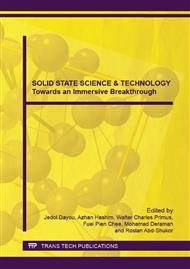p.415
p.420
p.426
p.432
p.437
p.443
p.449
p.454
p.460
Optical Properties of Oxy-Chloride Tellurite Glass: Role of Samarium Ions
Abstract:
. Achieving tunable optical properties of inorganic glasses via optimized doping of rare earth ions is ever-demanding in photonics. Control and inhibition of luminescence quenching, nonradiative decay and multi-phonon relaxation responsible of reduction of optical performance remains challenging. Doping/co-doping of different rare earth ions, variation of modifiers and embedding metallic nanoparticles (NPs) are thought as alternative routes to enhance optical response are still underway. We examine the influence of samarium ion concentrations on the optical properties of oxy-chlorite tellurite glasses of the form (70-x)TeO2-15MgO-5Li2O-10LiCl-xSm2O3 with 0.0 x 2.5 mol% prepared using melt-quenching method. The structural and optical characterizations are performed via X-ray diffraction (XRD), Ultraviolet-Visible (UV-Vis) absorption and photoluminescence (PL) spectroscopy. The glass density increased from 4.509 - 4.770 with the increase of Sm2O3 contents from 0.0 2.5 mol %. The XRD spectra confirm the amorphous nature of the glass. The absorption spectra exhibit nine prominent peaks corresponding to the transitions from the ground to excited states and the PL spectra reveal four peaks. The optical energy band gap for direct and indirect transitions are increased and Urbach energy decreased from 3.448 - 3.497, 3.165 - 3.232 and 0.217 - 0.175, respectively with the increase of Sm3+ ion concentrations. Furthermore, the significant enhancement in UV-Vis and PL response display the strong influence of samarium ion on optical and structural properties. The mechanism responsible for enhanced optical properties are analyzed and discussed. The results suggest that our careful experimental studies may contribute towards the development of tellurite glass based solid state lasers.
Info:
Periodical:
Pages:
437-442
Citation:
Online since:
June 2015
Keywords:
Price:
Сopyright:
© 2015 Trans Tech Publications Ltd. All Rights Reserved
Share:
Citation:


